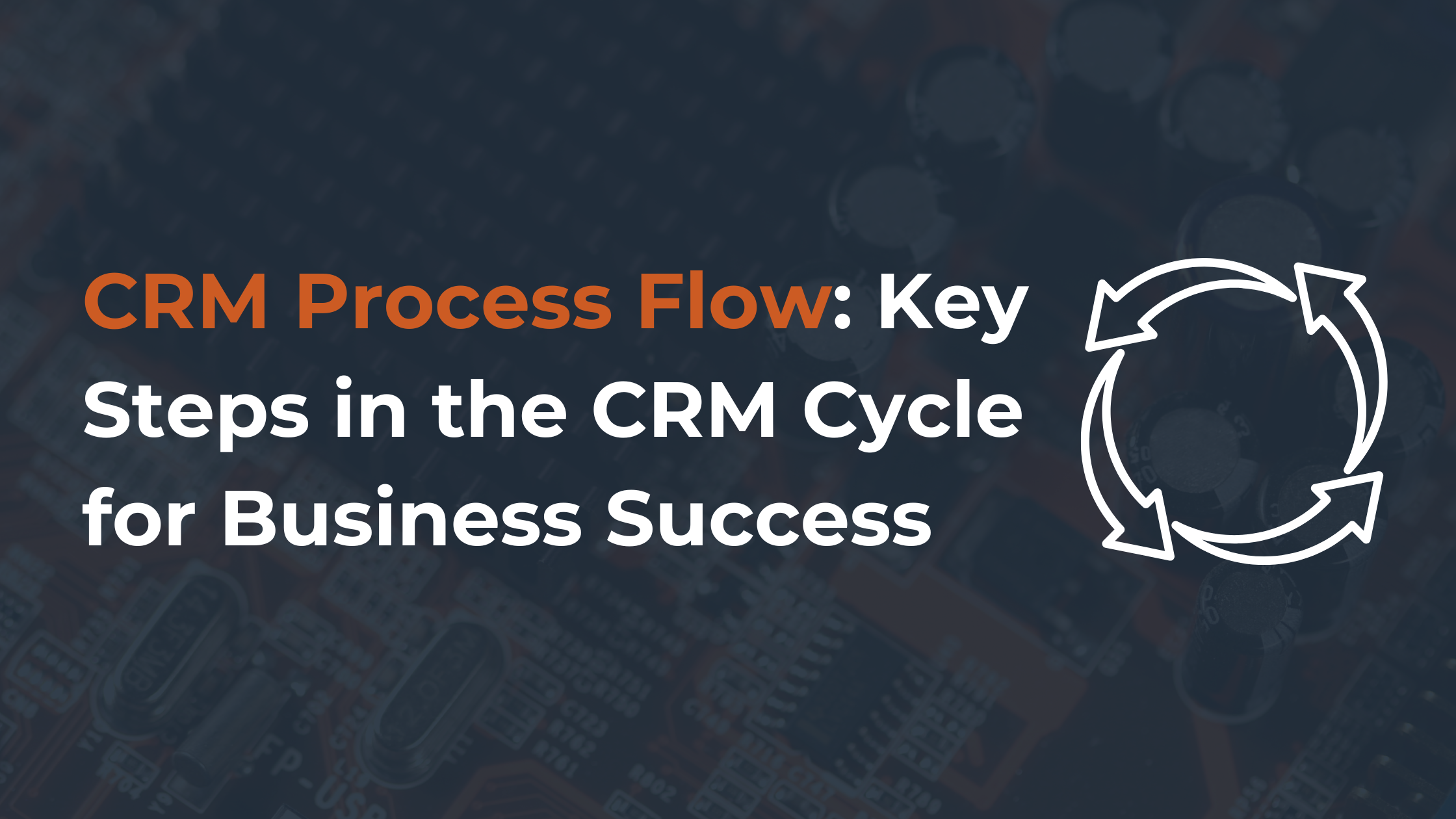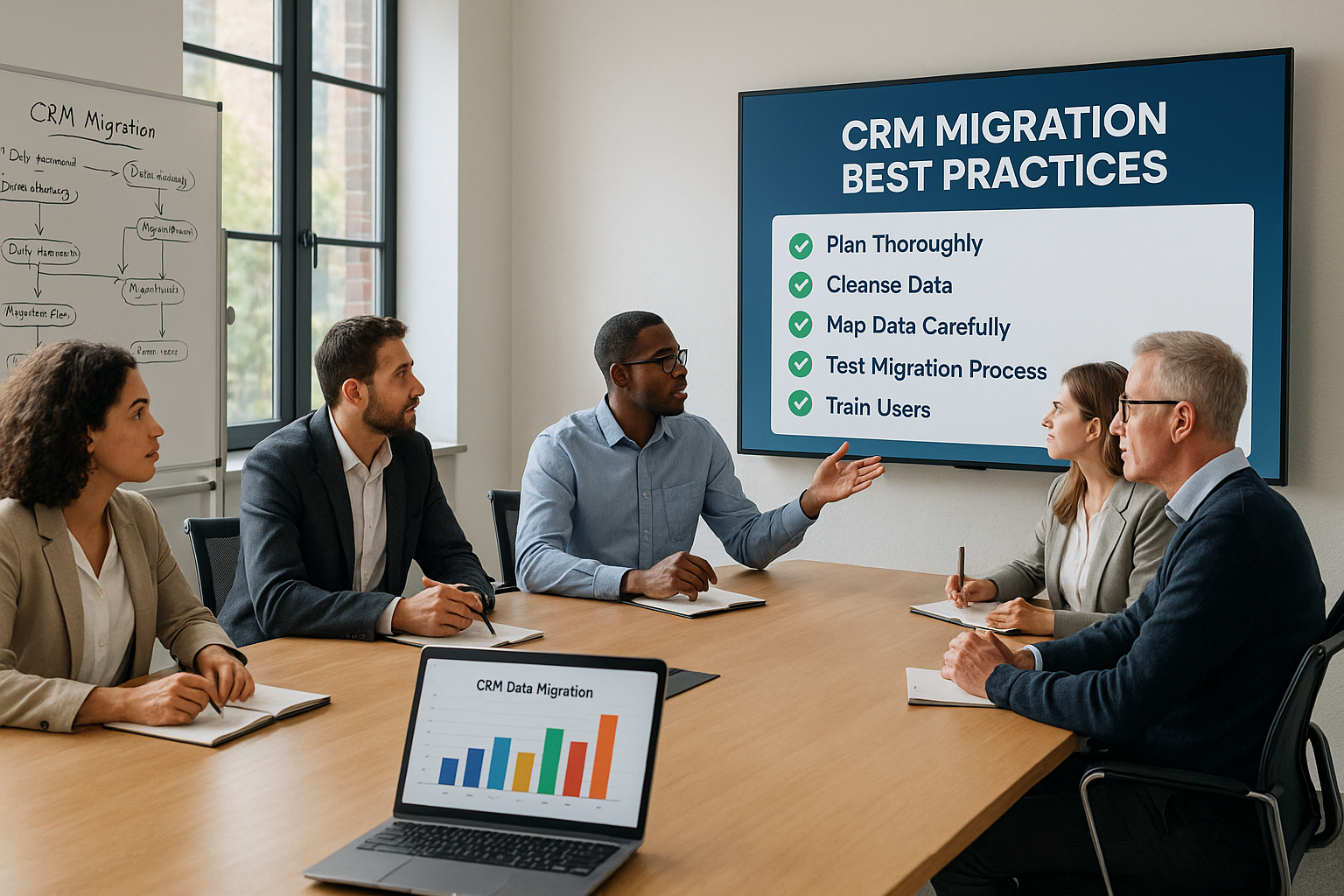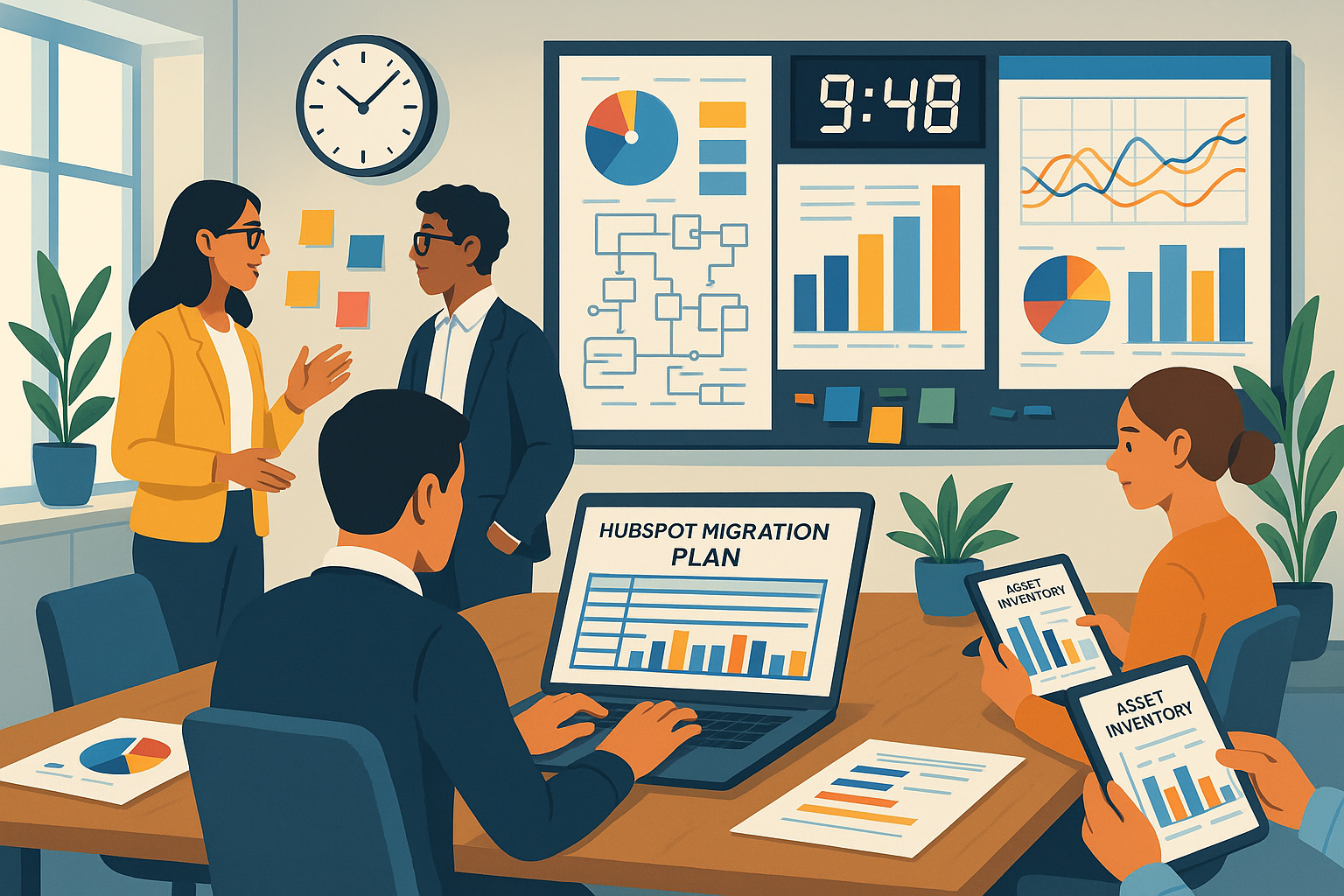This blog explores why structured CRM processes are crucial for modern businesses. It breaks down the five essential CRM steps and explains how each stage drives better relationships and growth.
The 5 CRM Process Steps:
- Lead Generation: Attract potential customers through marketing and outreach.
- Lead Qualification: Prioritize leads based on fit and readiness.
- Engagement: Build trust through personalized communication.
- Conversion: Close deals with a smooth and informed sales process.
- Retention: Support, upsell, and nurture long-term relationships.
- Better customer retention and loyalty
- Seamless collaboration between sales and marketing
- Improved segmentation and targeting
- Higher productivity through automation
- Increased customer lifetime value (CLV)
Keep reading to find out common CRM mistakes, essential metrics to track, and best practices for optimizing your CRM cycle for growth.
Table of Content
- Why CRM Processes Matter in Modern Business
- Overview of the CRM Process Cycle
- CRM Process Flow: The 5 Key CRM Steps Explained
- Benefits of Following a Structured CRM Process
- Best Practices for Optimizing Your CRM Process Steps
- Final Thoughts on Improving Your CRM Process Flow
- FAQ
Why CRM Processes Matter in Modern Business
Customer expectations have evolved. They demand fast responses, tailored experiences, and seamless interactions across every touchpoint. In this environment, a well-structured CRM process brings order to complexity by standardizing how businesses attract, engage, convert, and retain customers.
When CRM processes are clearly defined and properly implemented, businesses benefit from fewer dropped leads, shorter sales cycles, more accurate forecasting, and stronger customer relationships.
Overview of the CRM Process Cycle
.jpg?width=1024&height=768&name=CRM%20Process%20Cycle%20(1).jpg)
A successful CRM strategy doesn’t rely on chance; it’s built on a structured process that guides how businesses interact with prospects and customers at every stage. The CRM process cycle is the foundation that ensures these interactions are consistent and efficient.
What is the CRM Process?
The CRM process is a series of coordinated steps businesses follow to manage customer relationships from the first point of contact through long-term retention. Each stage involves different teams and tools, but the core objective remains the same: to deliver a seamless and personalized customer experience.
Rather than treating customer engagement as a one-off effort, the CRM process creates a continuous loop. New leads enter the system, pass through qualification and sales stages, and, once converted, are supported and nurtured for repeat business and referrals.
Importance of Structured CRM Steps
Having clearly defined CRM steps is essential for efficiency and accountability. A structured CRM process brings clarity because each team knows its role, timelines are adhered to, and customer information is always up-to-date and accessible.
Structured steps also make it easier to identify bottlenecks, measure performance, and improve over time. Whether you’re scaling your sales team, launching new campaigns, or enhancing customer service, a well-documented CRM cycle gives you the control and visibility needed to grow.
What are the steps in the CRM process? Let's find out below!
CRM Process Flow: The 5 Key CRM Steps Explained
A strong CRM process is a structured path that guides potential customers from the first point of contact through to loyalty and advocacy. Below, we break down a 5-step CRM process that every business should implement and optimize.
🎯 Step 1 – Lead Generation: What Is the First Step in the CRM Process?
So, what is the first step in the CRM process? Lead generation is the initial step in the CRM process. It’s where businesses attract potential customers. This could be done through digital marketing campaigns, SEO-driven content, paid advertising, social media engagement, trade shows, or referrals. The goal is to capture interest and gather key information, such as names, emails, or phone numbers, to initiate the relationship.
Modern CRMs play a vital role here by automatically logging every interaction and storing contact details for future segmentation and nurturing. They can also assign leads to specific campaigns or sales reps and trigger automated responses such as welcome emails. Without a steady and well-organized lead generation process, businesses risk missing out on high-potential opportunities at the very start of the customer journey.
🔍 Step 2 – Lead Qualification and Initial Contact
Once leads are in the system, it’s time to evaluate their readiness and fit. Not every contact will be a good match; some might just be browsing, while others may be serious buyers. Lead qualification helps prioritize efforts by scoring leads based on predefined criteria such as industry, budget, level of interest, or timing.
Using a CRM, sales and marketing teams can tag and score leads automatically, categorize them into appropriate segments, and route them to the right team. This ensures that no time is wasted on cold or mismatched leads. Initial contact (a personalized email, a phone call, or a product demo invitation) is the first real step in building a contact.
🤝 Step 3 – Relationship Building and Engagement
At this stage, the goal is to nurture leads through consistent, personalized engagement. This involves understanding their needs, answering questions, addressing objections, and offering relevant content or solutions. It’s a crucial part of the sales journey where trust is developed and value is demonstrated.
CRM tools empower teams with a 360-degree view of the customer. Every email sent, page viewed, or call made is logged, making it easier to tailor messages and follow-ups. Automated drip campaigns, webinar invites, whitepapers, and case studies are often part of this step. Strong engagement at this stage keeps leads warm and steadily moves them closer to conversion.
🖊️ Step 4 – Conversion and Closing the Deal
Once the lead is qualified and engaged, the focus turns to conversion — the next point of the customer relationship management process steps. This is where your sales process should peak, delivering proposals, negotiating terms, and finalizing the agreement. The key here is to make the buying process as seamless and confident as possible.
CRMs support this phase with tools like pipeline management, e-signature integrations, deal tracking, and collaborative notes. Sales reps can reference the lead’s entire journey to anticipate concerns and personalize their pitch. A smooth, professional closing process reflects well on the brand and can be the deciding factor for many buyers.
🔁 Step 5 – Post-Sale Follow-Up and Customer Retention
When we think about loyal customers, we often picture someone who repeatedly returns to purchase their favorite items from a familiar brand. However, repeat buyers can also represent opportunities for higher-value purchases through product upgrades.
So, how can businesses encourage customers to explore premium options? A good starting point is sending personalized product suggestions via email. With the help of your CRM, you can segment your audience into dynamic lists based on shared buying behavior. This allows you to craft targeted email campaigns that highlight new or upgraded products for specific customer groups.
For service-focused businesses, upselling often begins with regular check-ins. Use your CRM to schedule follow-up calls with returning clients, not just to maintain the relationship, but to uncover changing needs that could point to more advanced solutions. What worked for them last quarter may no longer be enough today, and a thoughtful outreach could open the door to an upsell.
|
Step |
Focus |
Key Activities |
CRM Tools/Features Used |
|
1. Lead Generation |
Attracting potential customers |
Campaigns, ads, content marketing, landing pages, form submissions |
Web tracking, lead capture forms, campaign analytics |
|
2. Lead Qualification & Initial Contact |
Identifying high-potential leads |
Scoring, segmenting, outreach, scheduling calls/emails |
Lead scoring, segmentation, automated workflows, contact management |
|
3. Relationship Building & Engagement |
Nurturing interest and trust |
Follow-ups, providing info, addressing objections, content delivery |
Email automation, engagement tracking, notes/history logs |
|
4. Conversion & Closing the Deal |
Turning leads into customers |
Product demos, proposals, negotiation, finalizing contracts |
Pipeline management, e-signatures, deal tracking, quotes |
|
5. Post-Sale Follow-Up & Retention |
Supporting and retaining customers |
Onboarding, feedback, upselling, customer support |
Task reminders, support tickets, satisfaction surveys, retention analytics |
Benefits of Following a Structured CRM Process

When organizations follow a defined CRM process flow, they create clarity across teams, reduce friction in the customer journey, and maximize the value of every interaction. Here’s a closer look at the key benefits:
Improved Customer Relationships and Retention
At its core, CRM is about relationships. A structured process helps ensure no interaction is missed, forgotten, or duplicated. With a complete view of every customer (purchase history, preferences, support tickets, and previous conversations), teams can deliver more personalized and timely communication. This level of care builds trust and loyalty. Customers feel understood, which increases their likelihood of staying with your business over the long term.
Streamlined Sales and Marketing Efforts
When sales and marketing efforts are guided by a unified CRM process, handoffs between departments become seamless. Marketing can deliver qualified leads directly to sales at the right time, with full visibility into how those leads were nurtured. Meanwhile, sales can follow up with the right messaging and context. Automation tools within CRM platforms further streamline this by managing tasks like lead scoring, follow-ups, and campaign tracking, helping teams work more efficiently and close deals faster.
Enhanced Customer Segmentation and Targeting
A structured CRM technology enables dynamic segmentation based on behavior, demographics, or lifecycle stage. This means you can tailor marketing campaigns to very specific groups, such as loyal repeat buyers, inactive customers, or leads in a certain region. Segmentation ensures that your messaging is always relevant, increasing engagement and conversion rates.
Increased Team Productivity and Automation
By automating routine tasks, like sending reminders, updating deal stages, or logging activity, a structured CRM process reduces manual work. This frees up your teams to focus on building relationships or analyzing performance. It also improves accountability, as everyone knows what steps come next and who is responsible.
Higher Customer Lifetime Value (CLV)
Consistent CRM process steps improve every phase of the customer journey from onboarding to upselling. By staying connected and offering ongoing value, businesses can drive repeat purchases, foster loyalty, and grow customer lifetime value. Over time, this has a direct impact on revenue and profitability.
Best Practices for Optimizing Your CRM Process Steps
Here are best practices for refining your CRM process, starting with what to avoid and what to measure.
Common Mistakes in CRM Processes and How to Avoid Them
Even well-intentioned CRM strategies can fall short if not properly maintained. Here are some of the most common pitfalls and how to address them:
- Lack of defined processes: Without clearly defined steps, CRM adoption becomes inconsistent across teams. Avoid this by mapping each stage of the CRM cycle and aligning your workflows with it.
- Inconsistent data entry: Inaccurate or missing data leads to poor customer experiences and unreliable insights. Use mandatory fields, validation rules, and automated data capture to maintain data quality.
- Overcomplicating workflows: Overloaded pipelines and redundant tasks slow teams down. Simplify your CRM workflows to focus only on essential actions, and review them regularly for relevance.
- Underutilizing CRM features: Many organizations fail to take full advantage of automation, integrations, or reporting tools. Invest in regular team training and explore the platform’s capabilities fully.
- Neglecting post-sale engagement: Focusing only on acquisition overlooks the potential of existing customers. Build post-sale follow-ups and retention strategies directly into your CRM workflows.
Metrics to Track at Each Stage of the CRM Cycle
To optimize your CRM process, you need visibility into what’s working and what isn’t. Here are key metrics to monitor at each step of the CRM cycle:
|
Stage |
Key Metrics to Track |
|
Lead Generation |
Number of new leads, lead source performance, website conversion rate |
|
Lead Qualification |
Lead score distribution, qualification rate, average time to qualify |
|
Engagement & Nurturing |
Email open/click-through rates, response times |
|
Conversion |
Deal win rate, average deal size, sales cycle length |
|
Post-Sale & Retention |
Customer satisfaction score (CSAT), Net Promoter Score (NPS), repeat purchase rate, churn rate |
Tracking these metrics allows businesses to identify friction points, optimize outreach, and better allocate resources. Over time, this leads to improved performance across the entire customer lifecycle.
Final Thoughts on Improving Your CRM Process Flow

In conclusion, efficient CRM process steps foster better relationships, clearer team alignment, and data-driven growth. By breaking the cycle into defined steps, you create a reliable framework that supports both customer satisfaction and business performance.
However, the real impact comes when your CRM process is continually refined with the right tools and insights. That means avoiding common pitfalls, automating where it makes sense, and tracking the right metrics at each stage. Whether you’re scaling your sales team, expanding into new markets, or simply aiming to deliver a better customer experience, your CRM process needs to be agile, measurable, and aligned with your broader goals.
At SyncMatters, we specialize in helping businesses unlock the full potential of their CRM solutions. From seamless integrations to data migrations, we ensure your CRM process is built for growth. If you want to integrate systems or migrate data, our team is here to help. Contact us today!
FAQ
What is the CRM process cycle?
The CRM process cycle is a structured sequence of steps that businesses follow to manage and grow customer relationships. It begins with attracting potential customers, continues through nurturing, converting, and supporting them, and ends with long-term relationship management and retention.
What are the main steps in the CRM process?
What are the steps in the CRM process? The main steps typically include:
- Lead generation
- Lead qualification
- Relationship building
- Conversion
- Post-sale follow-up
What is the first step in the CRM cycle?
The first step is lead generation. This involves identifying and attracting potential customers through channels like digital marketing, social media, referrals, or SEO-driven content. A CRM solution helps organize and track these leads.
Can small businesses benefit from CRM processes?
Yes. It helps small businesses stay organized, maintain consistent communication, and build stronger customer relationships even with limited resources. With the right CRM system, small teams can automate follow-ups, track customer interactions, and compete with larger organizations through personalized service.
Can the CRM process be automated?
Yes, many parts of the CRM processes can and should be automated. Tasks like lead assignment, follow-up emails, task reminders, and even parts of customer onboarding can be handled automatically within most modern CRM software.




